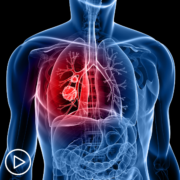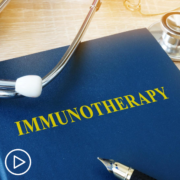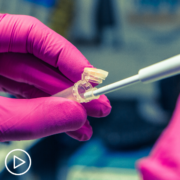Lung Cancer Treatment Approaches: What Are Your Options?
Lung Cancer Treatment Approaches: What Are Your Options? from Patient Empowerment Network on Vimeo.
How is lung cancer treated? Dr. Jessica Bauman provides an overview of lung cancer treatment modalities, including surgery, radiation and systemic therapies such as chemotherapy, immunotherapy, and targeted therapy.
Dr. Jessica Bauman is assistant professor in the department of hematology/oncology and as associate program director of the hematology/oncology fellowship training program at Fox Chase Cancer Center in Philadelphia. Learn more about Dr. Bauman here.
See More From the The Pro-Active Lung Cancer Patient Toolkit
Related Programs:

Establishing a Lung Cancer Diagnosis: How Do Subtypes Affect Treatment Choices? |

Why You Should Consider a Clinical Trial for Lung Cancer Treatment |

|
Transcript:
Katherine:
Would you walk us through the currently available lung cancer treatment approaches and who they might be right for?
Dr. Bauman:
So, we talked about this a little bit, but I would say, so, certainly, the different types of lung cancer treatment depends on the stage of the cancer.
But in general, I’m thinking about the broad categories that we have. So, number one being surgery. So, surgery is absolutely one of the most important aspects of lung cancer treatment that we have and is one of the ways in which it is possible to cure lung cancer. So, surgery can happen both as an open surgery, but there are also more minimally invasive surgeries now that have also revolutionized the way they can do surgery in lung cancer. And so, that absolutely plays a very significant role in the treatment of lung cancer.
The second broad approach that I would say is that of radiation. So, radiation also plays a very critical role in lung cancer, often more in advanced-stage disease for patients who have, for example, stage III disease, where the treatment that we consider is a combination of chemotherapy and radiation also with curative intent.
So, the idea behind this is that it’s cancer that is still in the chest, but it has spread to the lymph nodes in the chest, and a combination of chemotherapy and radiation may still be able to cure patients of this cancer. And so, radiation also can play a critical role. And interestingly, in small cell – which we’ve spoken a little bit less about – radiation and chemotherapy play a very important role in small cell, and often surgery plays less of a roll in small cell. And so, our treatment approach using radiation is in both of these kinds of cancers, and often we’re doing a full course of radiation also in an attempt to cure the cancer for the patient.
The last, sort of, broad category of treatment that I would say is what I call “systemic treatments.” So, that is targeted treatment. That is chemotherapy. And that is immune therapy.
And what we use of those three types of treatments completely depends on the patient’s stage and more information about that patient’s tumor, in particular, the molecular testing as well as what we say is called PD-L1, which is a marker on the tumor that tells me about the responsiveness to immunotherapy.
Often, we use a combination of many of these treatments. So, there are patients who get surgery and then chemotherapy. There are patients who get chemotherapy and radiation and then surgery. And there are patients who get only what we call systemic therapies.
I will also say it’s important to note that for radiation, although there’s a proportion of people that we use radiation with curative intent for a long period of time – so, a six-week course of radiation – we also use radiation to help with symptom management if someone’s having a specific problem that’s causing them a symptom where radiation may help.
The classic example of that is pain. So, if they have a spot in the bone that is causing them a lot of pain, a short course of radiation to shrink that tumor where that is, can be very helpful. And so, radiation we can also use to help with palliation of symptoms. The other things that I’m not getting into significantly today, but are also there, are there are other types of procedures that have become more common where you can go in, for example, with an interventional radiologist and do an ablation of a tumor.
Our interventional pulmonologists also do significant amount of ability to access the lungs and the lymph nodes to be able to help with diagnosis, but they can also do something like a debulking procedure where they can get rid of some of the cancer to stop it from bleeding.
They can also stent open the cancer to help people breathe better. So, there are multiple different other team members who also are really critical to our patient’s care.










